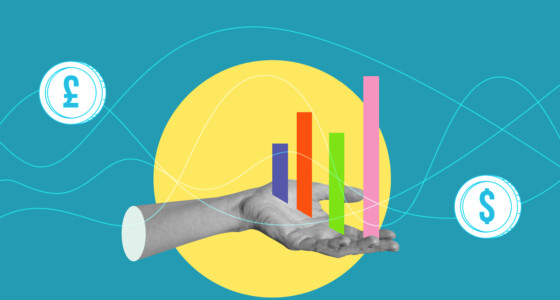

Algorithmic trading follows instructions that allow investors to place and execute trades automatically. However, this doesn’t mean a trader doesn’t have to do anything to get rewards. The trader’s task is to choose the strategy that will suit their trading style, amount of funds, risk management, and goals.
Algorithmic trading became allowed in India in 2008 when the SEBI issued a memorable circular stating the country opened its markets to algo-trading. Since 2011, the turnover percentage, based on algo-trading, has increased by over 50% on the BSE’s Equities.
Below you can find the best algorithmic trading strategies.
Types of algorithmic trading strategies
Let’s start with key types of algo-trading strategies.
1. Momentum
Momentum is the basic algorithmic trading system. The idea behind it is to catch a strong market trend.
- This strategy can be used for simple trades. For instance, you can invest in five shares that perform better than others according to annual performance metrics.
- You can make the strategy more comprehensive using both relative and absolute momentum. Investors can change the momentum system periodically — for instance, every week, month, quarter, or year.
2. Mean reversion
There is a common belief that the price reverts to its average value after it’s oversold or overbought. The idea of the mean reversion strategy is to determine the long-term average price and find an oversold or overbought asset. If it’s oversold, you should buy it and sell it when the price reaches the center of the trading range (average price). When the price is overbought, investors sell the asset and buy it when the price reaches the middle point of the trading range.
3. Seasonality strategies
When trading, it’s important to know the periods with higher and lower returns. For instance, the share market usually has higher returns during summer and at the end of the year. Many investors prefer to sell their losing trades by the end of the year to take advantage of the tax break. September is supposed to be the month with the lowest returns. Also, it’s worth remembering that stock prices fluctuate significantly by the end of a quarter and near the holidays.
Sniffing trading algorithms
Besides standard algorithmic systems, there are so-called sniffing algorithms. They are used to determine whether an algorithm is used by a trader/investor on the other side. For instance, a seller can identify whether a buyer uses any algorithms. This helps detect large order opportunities and enables an investor to have a successful trade by filling the orders at a higher rate.
Benefits of Algorithmic Trading
Algorithmic trading has several benefits a trader may enjoy. These can include:
· Increased speed: Algorithm trading is capable of examining various technical indicators and parameters to execute a trade. This allows traders to grab a price wing as soon as it happens.
· Accuracy: Human error is the cause of many trades being lost. Algorithm trading will analyze technical indicators correctly and not misjudge them, double-checking every trade.
· Lower Transaction Costs: Different technologies are used to find the best trades, reducing transaction costs. Traders will no longer have to check their devices frequently, as the process is done automatically for them. Without constant supervision, trading costs are lower.
With algorithm trading, day traders can make transactions at a higher rate, without the risk of human error. This brings more chances for profit, as traders may conduct several trades per day, or even per minute.

Algorithmic trading strategies: examples
Although there are numerous algo-trading techniques, this article covers the most uncommon ones. You can find more strategies here.
1. Dollar-cost averaging
This approach can be easily implemented in algorithmic trading. The idea is to invest a fixed amount of capital in a certain asset periodically. It’s one of the most effective long-term investing approaches. The logic is that price fluctuations may allow you to buy the asset cheaper than if you were to invest the whole amount at once.
2. Rebalancing of an index fund
There are defined periods when index funds rebalance their holdings to par with their respective benchmark indices. The rebalancing offers opportunities for algorithmic traders, who capitalize on expected trades. The rewards depend on the number of stocks in the fund before the rebalancing. Algorithmic trading allows executing trades on time and for the best prices.
3. Time-Weighted Average Price
This strategy takes one large order and breaks it up into several smaller chunks, sending it to the market. For this to happen, it will use time slots that were divided evenly between their starting time and their ending moment. The purpose of this strategy is to fulfill orders as close to the average price as possible, reducing the market impact.
4. Implementation Shortfall
This algorithmic trading strategy attempts to minimize potential order execution costs by not trading during the real-time market. This saves the order costs and brings profit from delayed execution costs. This strategy will also increase the rate of targeted participation when prices move at a favorable pace. At the same time, it will decrease once prices start moving adversely.
5. Percentage of Volume
This algorithm looks at the defined participation ratio gathered from the market volume. Using that data, it will send partial orders until the trade reaches completion. Combined with other strategies, it can send orders at a market user percentage that was defined by the user. It can also decrease or increase the rate of participation, depending on whether stock prices reach the levels defined by the user or not.
Final thoughts
Algorithmic trading is an effective tool that allows an investor to save time, avoid mistakes caused by emotions, and multiply the number of trades. However, to apply an algo-strategy to your trades, you should develop a reliable strategy manually. Remember that any trading approach should be customized according to your goals, investment approach, amount of funds, and the asset you trade.
Disclaimer: No strategy can guarantee a 100% correct outcome of the trade.









